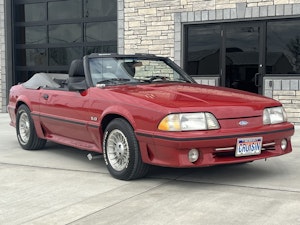Media | Articles
Diagnostic Dilemma: Not all scan tools are alike

John writes: I have three Jaguars insured through Hagerty—two XKRs (2006 and 2011) and one 2006 XJ8. I am looking for an OBD scanner that will give basic, easy-to-decipher code readings at a relatively low price. I am not mechanically inclined, and I’m tired of getting wrong advice from bad or unscrupulous mechanics.
Rob answers: There are three things to understand about scan tools. The first: There’s a distinction between generic OBD-II code readers and brand-specific scan tools. Any $20 generic OBD-II code reader will read the standardized OBD-II emissions-related codes that cause the Check Engine Light (CEL) to come on and tell you if a coil is misfiring or an oxygen sensor is out of range. However, the fact that the OBD-II/CEL system is standardized across all post-1996 cars means that an inexpensive code reader can only read the generic codes and thus can’t read Jaguar-specific codes. To do that, you need a Jaguar-specific scan tool.
Second, even with a Jaguar-specific scan tool, there’s a distinction between one that reads the Jaguar-specific control modules for the engine, transmission, airbag, ABS, suspension, parking sensor, and other systems, versus a tool that actually performs service functions on those systems. For example, finding and clearing a fault with the air suspension or the ABS is different from recalibrating the suspension or cycling the ABS for brake bleeding. The more you spend, the more of these service-type functions you get.
Third, the use of a scan tool is almost always coupled with hands-on repair. That is, a scanner may report an error code and give you the capability of clearing it, but if you or a repair shop haven’t corrected the underlying fault, the code will come right back. In addition, even with a b rand-specific scan tool that has an easy-to-understand user interface, some amount of brand-specific repair knowledge is often needed to translate the message into action. “Bad left rear wheel speed sensor” is pretty clear, but a “minor evaporative leak” could be coming from many small hoses, and it usually takes an experienced technician to figure out exactly which one it is.
That said, the Land Rover/Jaguar scan tools from iCarSoft and Foxwell both appear to be popular in the Jaguar world. The iCarSoft LR v1.0 ($190), will read and clear trouble codes and perform an oil service maintenance reset. The Foxwell NT630 ($150) will also perform the service functions of steering angle calibration and ABS bleeding. For $260, the iCarSoft LR v2.0 adds Electronic Throttle Control (ETC) and Battery Management System (BMS) reset.
Marketplace
Buy and sell classics with confidence
Andy Hoffman writes: Can I ask for clarification on the article “Winter is Coming” from the November/December issue? First, the article recommends putting the car on jack stands to avoid flat-spotting the tires. I always thought that would expose the [shock absorber] shaft to the elements and possibly cause corrosion, thus ruining the shock. I pull my cars onto pieces of rigid foam insulation, which contours (somewhat) to the tire and reduces the flat spot. What do you think? Second, the article recommends disconnecting the negative terminal of the battery to eliminate parasitic drain. Is that for cars with negative ground? If so, is the advice to disconnect the ground wire (to be clear, for those with positive ground)? Can you elaborate?
Rob answers: To prevent flat-spotted tires, parking on foam may be better than parking on cement, but Tire Rack concurs with my advice that the ideal solution is putting all four wheels up. Regarding the exposed-shock/strut-shaft issue, unless you’re in a salty/high-humidity environment, I wouldn’t be overly concerned. Many shocks and struts have bellows that cover the shaft, but if they don’t, some amount of the shaft is exposed anyway, even if the car is sitting on the ground.
Regarding which battery terminal to disconnect to eliminate the parasitic drain, the reason for disconnecting the negative is that most cars have negative ground. Therefore, if you accidentally touch the wrench to the body of the car when you’re undoing the negative terminal, you won’t create a spectacular short to ground and burn your hand. You are correct that, for this reason, on a car with positive ground, you should disconnect the positive terminal.
***
Rob Siegel’s latest book, The Best of the Hack MechanicTM: 35 years of hacks, kluges, and assorted automotive mayhem, is available on Amazon. His other seven books are available here, or you can order personally inscribed copies through his website, www.robsiegel.com.










For all future readers:
The iCarsoft is NOT suited for 2004-2009 (my findings so far) X350-X358 due to a software update that will make ECU communication almost impossible.
Stay away from iCarsoft